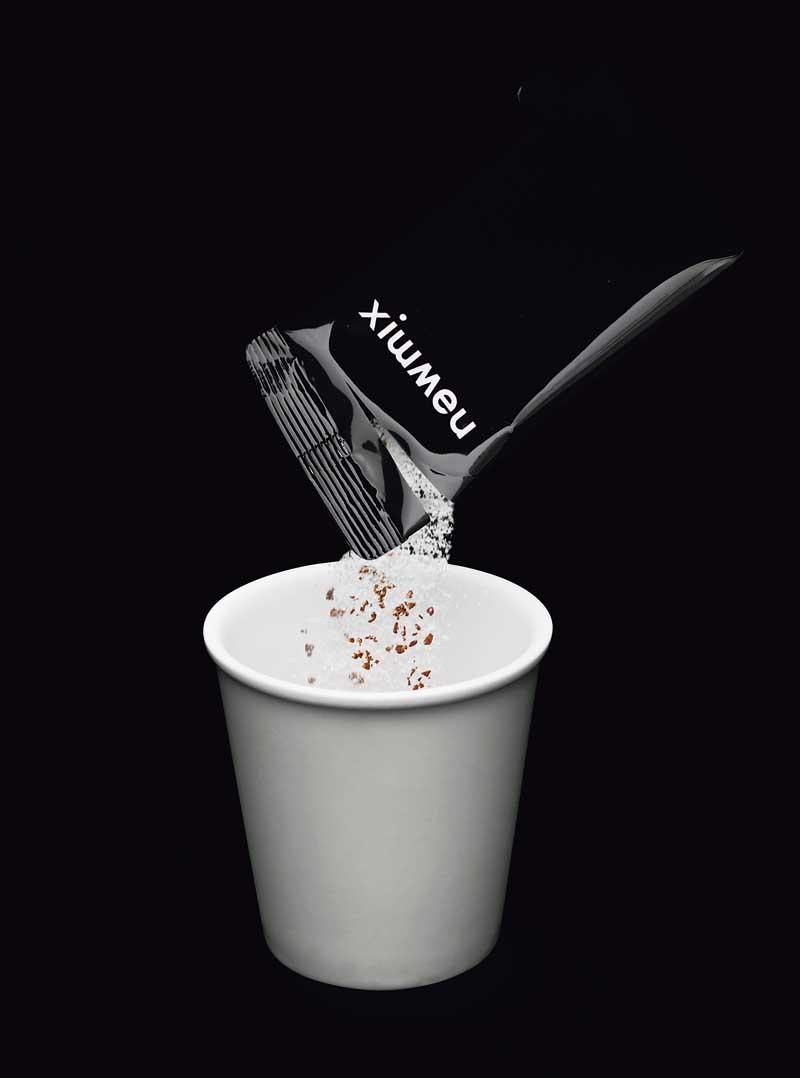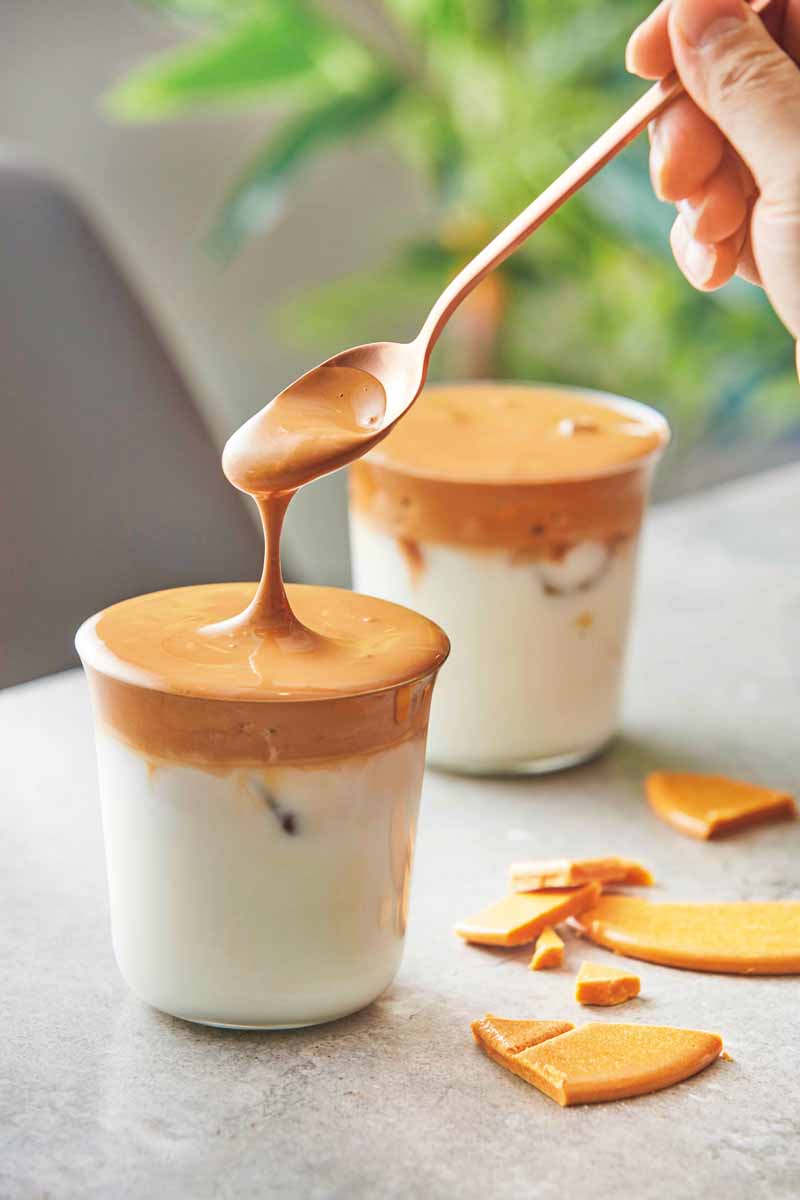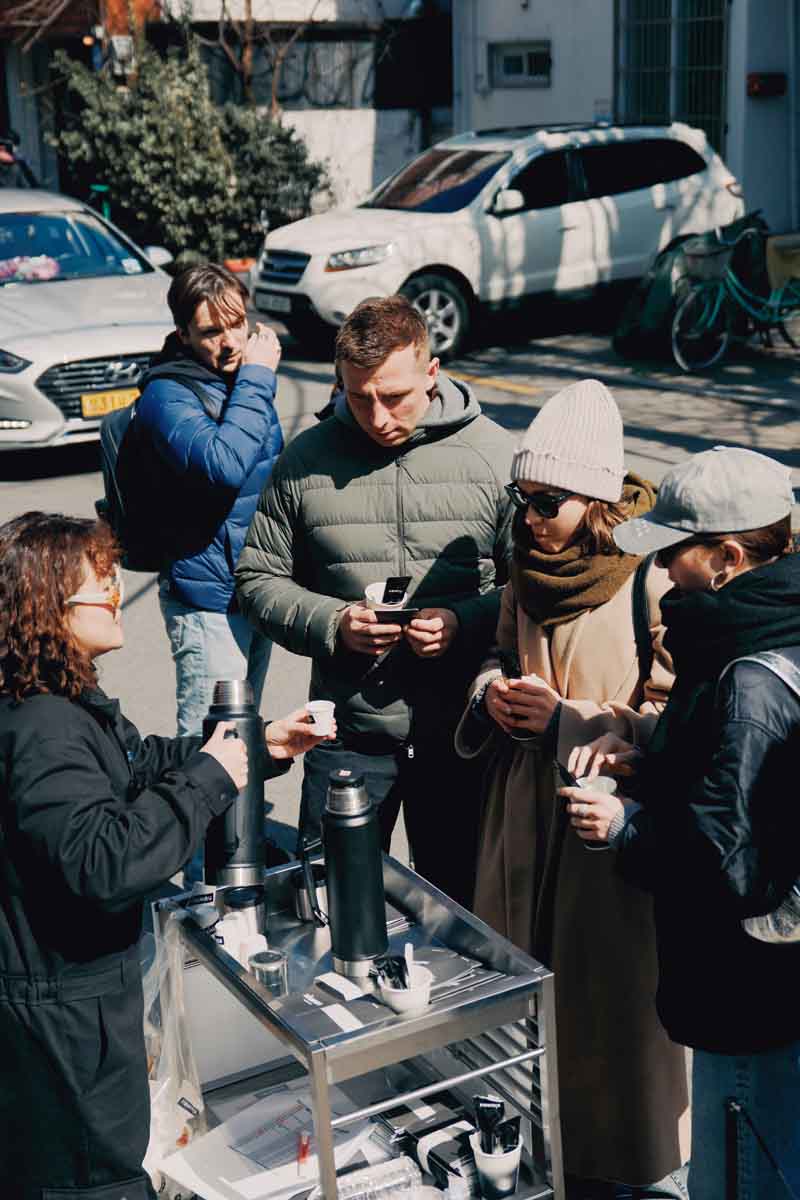Coffee mix — enjoyed simply by adding hot water — offers convenience in a cup. First introduced in the mid-1970s, it gradually entered the mainstream and is offered today by a wide variety of brands. Although consumption has declined since the 2010s with changing consumer tastes and perceptions, coffee mix remains firmly embedded in the daily lives of many Koreans.

Coffee mix combines instant coffee, sugar, and powdered creamer into a single-serve packet.
© Newmix Coffee
In Korea, “mix coffee” is a drink made by combining instant coffee with powdered creamer and sugar and mixing it with hot water. Yet it’s far more than the sum of its parts: For some, it’s a matter of personal taste; for others, it’s about finding solace. At one time, it reflected workplace hierarchies and relationships, and the invisible labor of the women who prepared it. Coffee mix, as we know it today in single-serve stick packs, emerged from this context. With everyone sipping coffee of the same flavor, a new era had begun. Beyond being fast and convenient, mix coffee became a Korean form of communication — emotion wrapped in technology. Consumer tastes may have changed, but even today, as the mix dissolves in hot water, its distinctive flavor carries the sentiment of times gone by.
EVERYDAY INGENUITY
Lee Jong-pil’s 2020 dramedy Samjin Company English Class features a scene where uniformed female employees race to see who can prepare a cup of mix coffee the fastest. Set in 1990s Korea, it follows women who dream of professional careers but, even after eight years working in the same office, still spend much of their time preparing coffee. Beneath its underlying humor, the film portrays the darker realities of that time. In one scene, a suspected office villain is identified by their preferred ratio of instant coffee, creamer, and sugar — a nod to a time when coffee preference was part of people’s identities.
However, this trend was short-lived. During the 1997 Asian financial crisis, women who only had high school diplomas were among the first to get laid off. Deemed expendable simply on account of their gender and education level, their disappearance removed the very workers who had prepared mix coffee and kept meeting rooms ready. The void left behind didn’t go unnoticed, especially when employees quickly realized just how inconvenient it was to prepare their own cup of coffee.
That’s when coffee mix came to the rescue. Anyone could tear open a packet, empty it into a cup, and add hot water to enjoy the same taste every time. It was more than just a beverage: It was efficiency in powdered form. Its status was underscored by the results of a 2017 Korean Intellectual Property Office survey ranking the “Top 10 Most Brilliant Korean Inventions.” In a testament to its lasting impact on Korean life, coffee mix placed fifth, behind only some inventions of great historical significance to Koreans — the writing system Hangeul, the iconic Joseon-era turtle ship, the world’s first movable metal type, and the traditional underfloor heating system known as ondol.
OUTDOOR ESSENTIAL
Coffee arrived in Korea in the late 19th century, though at the time it remained a luxury reserved for the royal court and high-ranking officials. It wasn’t until after the Korean War (1950–1953)that coffee became a popular beverage among the general population. Instant coffee, smuggled in alongside U.S. military rations, began appearing in dabang (old Korean-style teahouses), where it was used to make mix coffee, before gradually spreading across the country. This marked the rise of Korea’s own instant coffee tradition.
In 1970, Dongsuh Foods became the first Korean company to produce instant coffee. Six years later, it launched the world’s first all-in-one coffee mix, combining coffee, creamer, and sugar in a single-serve packet. The invention embodied the speed and spirit of Korea’s industrialization era, defined by the ppalli ppalli (“hurry hurry”) mindset.
At first, coffee mix was slow to catch on. Homes and offices already stocked separate glass jars of the three indispensable ingredients for a perfect cup — and most people still had the time to prepare coffee to their liking. As a result, coffee mix found its niche outdoors, where making coffee any other way was impractical. Many came to rely on coffee mix for a sugary boost of energy while taking part in recreational activities. As hiking, fishing, and other outdoor activities grew in popularity in the 1980s, so did the consumption of coffee mix. Its convenience made it a favored consumer choice, sparking intense competition as more companies sought to profit from this trend. Before long, coffee mix products had secured a significant share of the Korean coffee market.
LAYERS OF SYMBOLISM
It was not until after 1997 that coffee mix moved decisively indoors. With fewer support staff, increasingly demanding work conditions, and the widespread use of water dispensers, it became a staple in the office. Gone were the days of remembering each colleague’s individual coffee preferences — now everyone made their own from identical packets. Coffee was no longer a marker of social hierarchy and personal taste but a tool to get through the long working hours and a source of comfort.
Until the 1990s, people outside Korea regarded coffee mix as a uniquely Korean cultural oddity. In markets dominated by espresso, black coffee, and canned coffee, it came across as overly sweet and lacking in soul and personality. Since coffee has always been seen as a matter of personal taste and expression, a beverage that seemed to eliminate both was unlikely to be accepted.

Recently, younger people have begun experimenting with mix coffee by adding milk, ground cinnamon, banana, and other ingredients. A prime example is dalgona coffee: honey is whisked until frothy, then coffee mix is added and beaten into a thick, creamy mixture to be poured over milk.
© Korea Tourism Organization
However, this perception began to change with the rising worldwide popularity of K-dramas and Korean culture in general. Scenes of characters talking over a cup of sweet coffee mix gave it new emotional appeal. It became a Korean food export in markets such as Russia, Eastern Europe, Indonesia, Viet Nam, and Taiwan. In a 2016 survey of nearly 1,000 foreign tourists, conducted by a Korean travel agency, 53 percent named coffee mix as the “most delicious Korean beverage.”
While many flippantly claim they could not survive without coffee, back in 2022 that was quite literally the case for two miners who were trapped for 221 hours in a collapsed mine in Bonghwa County, North Gyeongsang Province. The two survived 190 meters underground by rationing coffee mix as a meal substitute, which allowed them to walk out unaided after their rescue. This is a vivid example of how the sugar, calories, and caffeine in coffee mix can sustain life in an emergency.
A NEW TAKE ON MIXING
Recently, coffee mix has been given new life. One example is newmix coffee, a brand launched by Kim Bong-jin, founder of the popular food delivery platform Baedal Minjok. With the slogan “Everything starts with a mix,” the brand revives the nostalgic feel of old dabang and office life. Showroom-style cafés in Seoul’s Seongsu and Bukchon neighborhoods recreate the aesthetics of Korea’s bygone coffee culture.
The appeal of coffee mix is not purely nostalgic. When brewed coffee first gained popularity in Korea, many found its bitterness off-putting, turning instead to sweeter alternatives such as caffè mocha and Frappuccino. Over time, Americano took hold, but in recent years sweeter, richer-tasting coffees have made a comeback. The growing popularity of cream latte, Einspänner, and Viennese-style latte reflects this shift in the preferences of younger consumers.

Tourists sample products outside the newmix café in Seongsu-dong. Launched in 2024, newmix is carving out a niche as “souvenir coffee” and “dessert coffee.” With flavors like roasted chestnut, cinnamon yakgwa (deep-fried honey cookies), and patbingsu (shaved ice topped with sweet red beans), the company offers a new twist on traditional coffee mix, ushering Korea’s iconic instant coffee into a new era.
© Newmix Coffee
Coffee mix was able to reinvent itself by riding this wave. It’s no coincidence that foreign visitors make up a large share of newmix coffee’s customers. They are drawn by the images of Korean coffee culture they’ve seen on social media and in K-dramas. For all its freshness and originality, however, it remains to be seen whether newmix coffee will become a global brand. But for today’s young people — whose salaries don’t keep up with soaring coffee prices — coffee mix offers an affordable way of enjoying a cup alone or with company.
Online, coffee mix features in recipes and YouTube videos, from caffè latte and cream coffee to Kahlúa cocktails. Responding to people’s growing interest in health and nutrition, manufacturers have introduced new products including zero-sugar, high-protein, and fat-free options, appealing alternatives between mainstream and specialty coffee.
According to the Ministry of Food and Drug Safety, coffee beverages accounted for the largest share of the domestic coffee market in 2022 at 35.6 percent. Even so, coffee mix remains a popular choice, accounting for 24.8 percent. In 2024, sales rose for the first time in a decade. That year alone, Dongsuh Foods sold around 5.7 billion packets of its flagship product, Maxim Mocha Gold — or about 180 per second. These numbers demonstrate that coffee mix remains firmly rooted in Koreans’ daily lives. Once a symbol of efficiency and solace, it’s now being reimagined by a new generation as a means of emotional connection. Coffee mix is Korea’s own take on coffee — one with the power to dissolve hierarchical distinctions tied to personal preferences and bring people closer, one sip at a time.